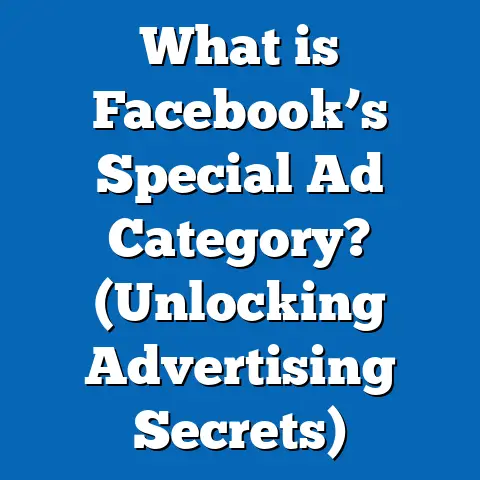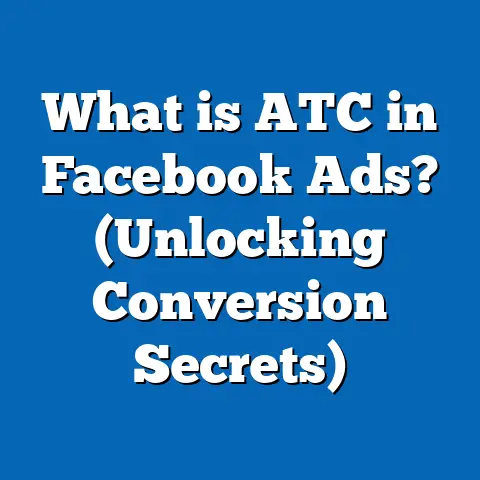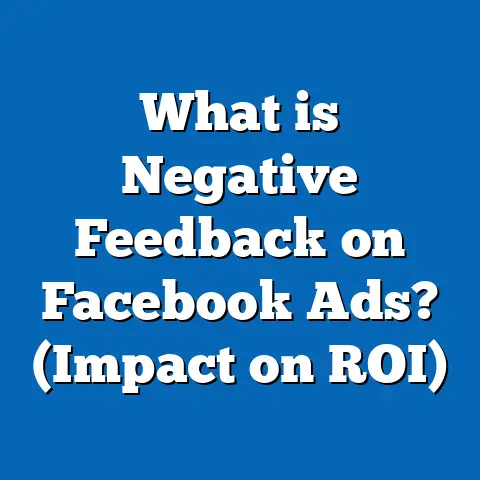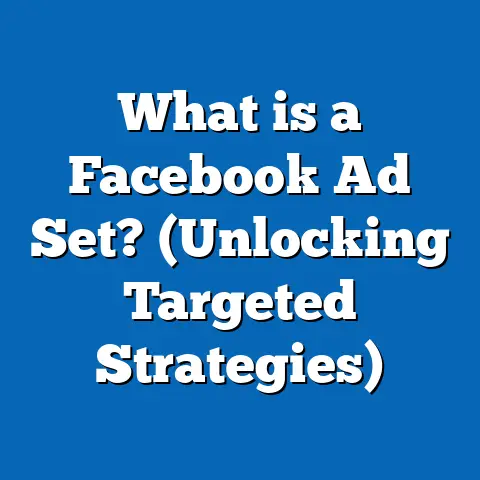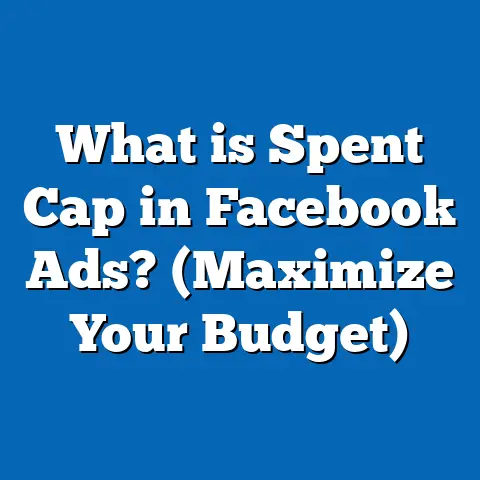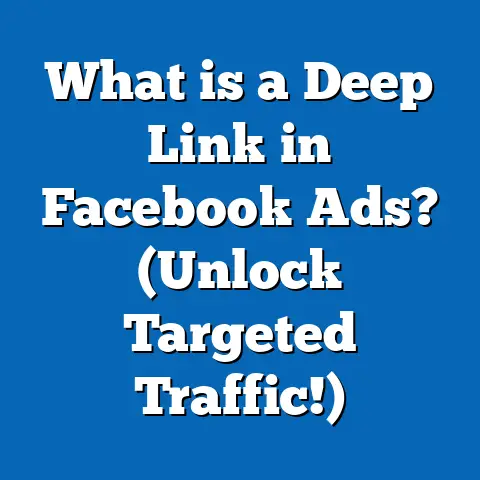What is Facebook Ad Engagement? (Unlocking Your ROI Potential)
What is Facebook Ad Engagement? (Unlocking Your ROI Potential)
Introduction: The Challenge of Measuring True Facebook Ad Success
For many marketers and business owners, running Facebook ads can feel like throwing darts in the dark. You invest time, money, and effort into campaigns but struggle to understand if your ads are truly resonating with your audience. The pressing question is: How do you measure success beyond just clicks and impressions? This is where Facebook ad engagement becomes a game-changer. It offers a deeper insight into how users interact with your ads, unlocking the potential to maximize your return on investment (ROI).
More than ever before, digital advertising requires precision and data-backed decisions. Simply putting up an ad is no longer enough; understanding engagement patterns allows marketers to refine targeting, messaging, and creative elements for better results. This guide will take you through everything you need to know about Facebook ad engagement — from fundamental concepts to advanced strategies — to help you unlock your ROI potential.
Understanding Facebook Ad Engagement
What Exactly is Facebook Ad Engagement?
Facebook ad engagement refers to the various ways users interact with your ads on Facebook’s platform. Engagement includes actions such as likes, comments, shares, clicks on links, video views, reactions, and other interactions that show active participation rather than passive viewing.
Engagement signals how interested a user is in your content and brand. It goes beyond just seeing an ad — it measures interaction which can reveal intent, curiosity, or approval. These signals help Facebook’s algorithm decide which ads to show more frequently and at a lower cost.
Why Engagement Matters More Than Ever
Facebook’s algorithm prioritizes content that generates meaningful engagement. Ads with higher engagement rates tend to reach more people organically and cost less per result due to better relevance scores.
- Stat: According to a study by WordStream, ads with high engagement receive up to 50% lower cost-per-click (CPC) than those with low engagement.
- Insight: Engaged users are more likely to convert because their interaction signals interest or intent.
- Example: A user who comments on an ad is demonstrating a higher level of interest than someone who just scrolls past it.
Engagement also provides social proof. When users see that others have reacted positively to an ad through likes or shares, it builds trust and credibility for your brand.
Types of Facebook Ad Engagement
Facebook tracks multiple types of engagement:
- Reactions (Like, Love, Haha, Wow, Sad, Angry)
- These quick emotional responses provide immediate feedback on how users feel about your ad.
- Comments
- Comments indicate deeper interaction and can be used to gauge sentiment or gather user feedback.
- Shares
- Shares amplify your ad’s reach organically by having users distribute your message within their networks.
- Clicks
- Includes link clicks (leading to your site or landing page), CTA button clicks (like “Shop Now” or “Learn More”), and page likes.
- Video Views and Completions
- For video ads, tracking views (especially longer watch times) shows engagement quality.
- Post Saves
- When users save an ad or post for later, it signals strong interest or intent to revisit.
Each type of engagement has a different value depending on your campaign goals — whether it’s brand awareness, lead generation, sales, or community building.
Breaking Down Facebook Ad Engagement Metrics
Engagement Rate: What it Means and How to Calculate It
Engagement rate is a key metric showing the percentage of people who saw your ad and engaged with it. Engagement Rate=(Total EngagementsTotal Impressions)×100\text{Engagement Rate} = \left(\frac{\text{Total Engagements}}{\text{Total Impressions}}\right) \times 100
- A higher engagement rate typically signals that your ad content resonates well with your audience.
- Average engagement rates vary by industry but typically range between 1% to 5% on Facebook.
- Industry Benchmark: Health & wellness campaigns often see higher engagement rates (<del>3-5%), while B2B ads might see lower but highly targeted engagement (</del>1-2%).
Other Important Metrics Linked to Engagement
- Click-Through Rate (CTR): Percentage of users who clicked on your ad after seeing it. Higher CTR usually correlates with better engagement.
- Cost Per Engagement (CPE): How much you pay on average for each engagement action; critical for budgeting and optimizing campaigns.
- Relevance Score (Quality Ranking): Facebook’s internal rating of how well your ad resonates with your audience (scale 1-10). Higher scores mean better engagement and lower costs.
- Video Average Watch Time: A metric specific to video ads showing how long people watch your video on average.
Why These Metrics Matter
Understanding these metrics helps you:
- Identify which ads connect best with your audience.
- Optimize budget allocation by focusing on high-engagement ads.
- Improve creative content based on what drives interaction.
- Predict conversion potential by measuring early-stage interest.
The Impact of Facebook Ad Engagement on ROI
How Engagement Drives Return on Investment
Engagement is a leading indicator of potential ROI because it reflects audience interest and interaction quality.
- Data Insight: Facebook reports that ads with the highest engagement tend to deliver up to 37% higher conversion rates.
- Engaged users often cost less to convert because they are already interacting with your brand.
- Engaged audiences also improve your ad’s organic reach through shares and comments.
Why Engagement Lowers Costs
Facebook rewards engaging ads with lower cost per impression (CPM) and CPC because they contribute positively to user experience on the platform.
- When users interact positively with an ad, Facebook algorithm boosts its delivery.
- Ads with poor engagement get penalized by reduced reach and higher costs.
Real-World Example: Case Study 1 — E-commerce Retailer
A mid-sized online retailer ran two Facebook campaigns promoting the same product:
- Campaign A focused on broad reach with low-engagement content.
- Campaign B targeted a niche audience with highly engaging video content.
Results after 30 days:
| Metric | Campaign A | Campaign B |
|---|---|---|
| Engagement Rate | 0.8% | 4.5% |
| CPC | $0.65 | $0.42 |
| Conversion Rate | 1.2% | 3.7% |
| ROI | 25% | 78% |
The data clearly shows that higher engagement led to better efficiency and significantly improved ROI.
Real-World Example: Case Study 2 — SaaS Company
A Software-as-a-Service (SaaS) company wanted to generate leads via Facebook ads. They tested two approaches:
- Static image ads focusing on features.
- Video testimonials from satisfied customers encouraging comments.
The testimonial videos had:
- A 60% higher comment rate.
- A 45% lower cost per lead.
- Increased trust leading to longer trial signups.
This underlines the power of authentic engagement-driven content in boosting ROI.
How to Boost Facebook Ad Engagement
Crafting Engaging Content
Use Eye-Catching Visuals and Videos
Visual content grabs attention more effectively than text alone.
- Videos generate 6x higher engagement than static images (Facebook internal data).
- Use bright colors, clear branding, and relevant imagery.
Write Compelling Headlines and Descriptions
Your copy should:
- Speak directly to audience pain points or desires.
- Include emotional triggers or curiosity gaps.
Example: Instead of “Buy Our Shoes,” say “Step Into Comfort Like Never Before.”
Include Clear Calls-To-Action (CTAs)
Encourage specific actions such as:
- “Comment below your thoughts”
- “Share if you agree”
- “Tap to learn more”
Explicit invitations increase participation rates.
Targeting the Right Audience
Utilize Facebook’s Detailed Targeting Options
Narrowing down demographics increases relevance:
- Interests
- Behaviors
- Locations
- Age groups
Create Custom Audiences
Retarget:
- Website visitors
- Past customers
- Email subscribers
These groups are more likely to engage because of prior exposure.
Use Lookalike Audiences
Find new users similar to your best customers for better engagement potential.
Leveraging Facebook Features for Engagement
Interactive Formats
- Polls in stories
- Carousel ads that encourage swiping
- Instant Experience ads for immersive interaction
Video Ads With Captions
Captions increase watch time by making videos accessible without sound.
Encourage Comments by Asking Questions
Example CTAs like “What’s your favorite feature?” can spark conversations and boost comment rates.
Advanced Strategies for Maximizing Engagement
Retargeting Engaged Users
People who engage with your ads are prime candidates for retargeting campaigns:
- Create custom audiences based on engagement behaviors (e.g., video viewers or post engagers).
- Serve them more personalized offers or messages to move them down the funnel.
Example:
If a user watched 50% of your product demo video but didn’t convert, retarget them with a limited-time discount offer.
Using Facebook Analytics for Deeper Insights
Facebook Ads Manager provides granular data on engagement:
- Analyze which posts receive the most interaction.
- Track engagement trends over time.
- Adjust budgets dynamically toward ads with higher engagement rates.
Use this data for ongoing campaign refinement.
Experimenting With Ad Placements
Try different placements:
- Feed
- Stories
- Marketplace
- Audience Network
Analyze which locations yield the highest engagement rates for your target audience.
Utilizing A/B Testing for Content Optimization
Run split tests comparing:
- Different headlines
- Various images/videos
- CTA button variations
- Targeting options
Data-driven decisions help you find the perfect formula for maximizing engagement.
Historical Context: How Facebook Ad Engagement Has Evolved
When Facebook first introduced ads in 2007, they were simple sponsored posts primarily focused on reach. Over time, as competition increased and user behavior evolved, Facebook shifted focus toward meaningful interactions — reactions, comments, shares — as core indicators of success.
With the introduction of video ads in 2015 and interactive formats later on, advertisers gained new ways to spark engagement beyond clicks. Today’s algorithm heavily favors ads that keep users interacting within the platform rather than just clicking away.
Comparing Facebook Ad Engagement With Other Platforms
| Platform | Typical Engagement Types | Average Engagement Rate | Unique Strengths |
|---|---|---|---|
| Reactions, shares, comments, clicks | 1%-5% | Large user base, diverse ad formats | |
| Likes, comments, saves | 3%-6% | Visual-first platform, younger audience | |
| Likes, comments, shares | 0.5%-1.5% | B2B focus, professional targeting | |
| Retweets, likes, replies | 0.5%-2% | Real-time conversations, trending topics |
Facebook’s advantage lies in its combination of extensive targeting options and diverse engagement types that suit both B2C and B2B marketers.
Instagram tends to have higher raw engagement rates due to its visual focus but may lack some of Facebook’s deeper targeting capabilities for certain niches. LinkedIn excels in professional contexts but sees lower interaction volumes overall.
Common Myths About Facebook Ad Engagement
Myth 1: More Likes Always Mean Better Ads
Likes alone don’t guarantee conversions; quality of engagement matters more. Many likes may come from casual viewers rather than true prospects.
Myth 2: Engagement Is Only About Social Proof
Engagement serves as a performance metric that impacts ad costs and reach directly — it’s not just about making your brand look popular externally.
Myth 3: High Engagement Means You Can Ignore Other Metrics
While important, engagement should be evaluated alongside conversions and revenue metrics to assess true business impact.
Practical Tips for Tracking and Improving Engagement
- Regularly Monitor Your Ads – Check performance daily during campaigns.
- Test Different Creatives – A/B test images, videos, headlines.
- Optimize for Mobile – Over 98% of Facebook users access via mobile devices.
- Respond to Comments Quickly – Build community and encourage further interaction.
- Use Lookalike Audiences Based on Engagers – Expand reach efficiently.
- Leverage User Generated Content (UGC) – Ads featuring real customers often boost authenticity and interaction.
- Schedule Posts When Your Audience Is Most Active – Use Facebook Insights to identify peak times.
- Incorporate Trending Topics Where Relevant – Timely content can spark more conversations.
Future Trends in Facebook Ad Engagement
Increased Use of AI for Personalization
Facebook is investing heavily in AI-driven ad targeting and creative optimization tools that automatically tailor content based on user behavior patterns.
Growth of Augmented Reality (AR) Ads
AR ads allow users to virtually try products or interact with branded experiences directly within the app — driving deep levels of engagement.
More Integration Between Facebook Shops and Ads
Seamless shopping experiences integrated into ads will reduce friction between engagement and purchase actions.
Staying ahead means experimenting early with these emerging features as they roll out.
Summary and Next Steps
Facebook ad engagement is a critical factor in understanding how effectively your ads connect with your audience. Higher engagement not only improves organic reach but also lowers advertising costs while increasing conversions and ROI. By focusing on creating relevant content, smart targeting, and continuous optimization based on engagement metrics, marketing professionals and business owners can unlock their full advertising potential on Facebook.
Key Takeaways:
- Engagement includes likes, comments, shares, clicks, and video views.
- Higher engagement rates typically lead to lower costs and better ROI.
- Use detailed targeting and engaging creatives to boost interactions.
- Retarget engaged users for greater conversion potential.
- Track and analyze engagement metrics regularly for ongoing improvement.
Start by auditing your current campaigns’ engagement levels today and experiment with content designed specifically to encourage interaction. This will put you on the path to unlocking your true ROI potential through Facebook advertising.
If you want me to include detailed templates for campaign planning or reporting dashboards tailored around engagement metrics next, just let me know!

